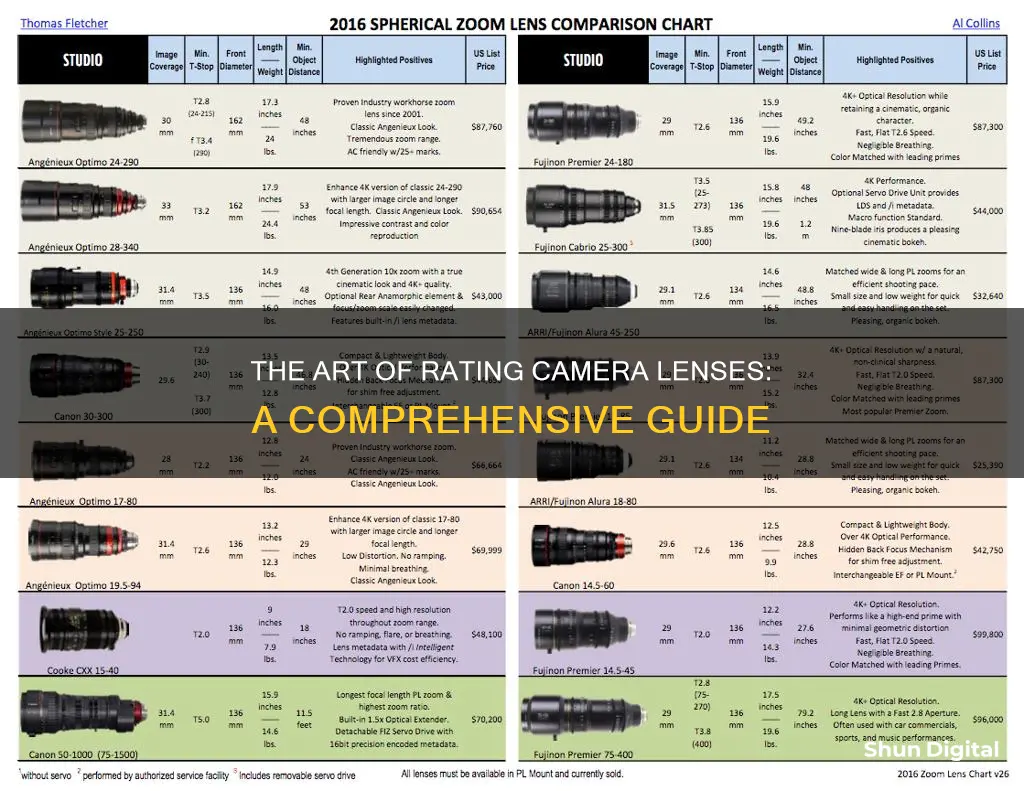
Camera lenses are one of the most important pieces of equipment a photographer can buy. When it comes to rating or choosing a camera lens, there are several factors to consider. These include sharpness, clarity, colour accuracy, distortion control, focal length, aperture or f-number, and more.
The lens's focal length determines its angle of view and how much the subject will be magnified. Wide-angle lenses have short focal lengths, while telephoto lenses have longer ones. The aperture range refers to the amount of light the lens lets in, with larger apertures often described as faster as they allow for faster shutter speeds.
Other factors to consider include the lens's construction, weight, autofocus performance, durability, ergonomics, and price. Modern lenses typically have several lens elements that work together to direct light rays and recreate the image accurately on the digital sensor.
When rating camera lenses, it's essential to look at the combination of these factors and how they impact the overall image quality, cost, flexibility, and ease of use.
What You'll Learn

Sharpness and clarity
When it comes to camera lenses, sharpness and clarity are crucial factors in determining image quality. Here are some insights to help you understand and evaluate the sharpness and clarity of your camera lenses:
- Modulation Transfer Function (MTF) Chart: The MTF chart is a valuable tool for assessing lens performance. It illustrates how effectively a lens can transfer contrast from the subject to the image sensor. A lens with a high MTF score will typically produce sharper and clearer images.
- Lens Construction: The quality of lens construction also plays a role in sharpness and clarity. High-quality materials and solid build ensure the lens can withstand professional use and maintain its optical precision over time.
- Autofocus Performance: Modern lenses with good autofocus capabilities are essential, especially for capturing fast-moving subjects like in sports or wildlife photography. Fast and accurate autofocus ensures you capture the desired shot.
- Image Quality: A sharp lens will produce images with crisp details and well-defined edges. Clear lenses minimise haze or fog, enhancing overall image quality.
- Testing Methods: To test lens sharpness, consider using lens test charts like the United States Air Force lens test chart or its variations. A sturdy tripod, mirror up delay, and cable release can also help eliminate vibration during testing.
- Real-World Performance: Keep in mind that lab tests might not always reflect real-world performance. Factors like lighting, clear air, subject placement, and photographer technique play a significant role in achieving sharp and clear images.
- Lens Limitations: Understand the limitations of your lenses and work within those constraints. Stopping down the aperture slightly from the maximum can often improve sharpness by reducing aberrations and vignetting.
- Format Size: Larger formats, such as medium format or full-frame sensors, generally provide sharper images than smaller formats, assuming all other factors are equal.
- Natural Subjects: When testing sharpness, consider using natural subjects like trees or vegetation with fine fractal detail. These provide more realistic results than flat test charts, as real-world subjects rarely have perfectly flat surfaces.
- Focus Accuracy: Accurate focus is critical to achieving sharp images. Even slight errors in autofocus or manual focus can introduce unsharpness, so calibrate your focus system or use manual focus for critical shots.
- Lens Selection: Different lenses have different sharpness characteristics. Macro lenses, for example, are designed for close-up work and can provide exceptional sharpness at shorter distances.
Remember, while sharpness and clarity are important, they are not the only factors that define a good photo. Artistic expression, lighting, composition, and other technical aspects also contribute to creating compelling images.
Camera Lenses: Do They Have an Expiry Date?
You may want to see also

Distortion and vignetting
Types of Distortion
There are three main types of distortion: barrel, pincushion, and waveform (or mustache) distortion. Barrel distortion occurs when a lens is at full zoom, causing straight lines to curve outwards at the edges of the image. Pincushion distortion, on the other hand, is commonly seen in telephoto lenses, where the edges of the photo appear to bend inwards. Waveform distortion is a combination of both barrel and pincushion distortion, typically seen in large-angle cameras in zoom mode.
Measuring Distortion
The standard method for measuring lens distortion is defined by ISO 9039, which involves using a test chart with a regular grid of geometric structures. Another method, specified in ISO 17850, includes three different approaches: horizontal line distortion, vertical line distortion, and total line distortion, which take into account the position of lines in the image relative to the centre.
Vignetting
Vignetting can be caused by optics or purposefully added during post-processing. It can occur naturally in all lenses, especially prime lenses with large apertures. This is due to the partial blocking of peripheral light rays by the lens barrel at wide apertures. Additionally, light rays at the periphery of the lens travel a longer distance, resulting in a falloff in illumination towards the corners of the frame. Vignetting can also be caused by external tools such as filters, filter holders, and lens hoods.
Correcting Distortion and Vignetting
Software tools like Lightroom and Photoshop provide lens correction modules that can easily correct distortion and vignetting. These tools use lens-specific data to reverse the distortion effects created by the lens optics. Additionally, in-camera vignetting reduction features are available in some modern cameras, although they may have limited effectiveness on RAW images.
Cleaning Camera Lenses: A Step-by-Step Guide
You may want to see also

Chromatic aberration
There are two types of chromatic aberration: axial (longitudinal) and transverse (lateral). Axial aberration occurs when different wavelengths of light are focused at different distances from the lens, and is typical at long focal lengths. Transverse aberration occurs when different wavelengths are focused at different positions in the focal plane because the magnification and/or distortion of the lens also varies with wavelength; this is typical at short focal lengths.
When identifying a good camera lens, look for one with minimal chromatic aberration, resulting in sharp and clear images with accurate colours. Other desirable features include a wide aperture, image stabilisation, compatibility with your camera body, and a good brand reputation.
Camera Lenses: Reselling and Buying Used
You may want to see also

Bokeh and depth of field
A good camera lens should produce pleasing bokeh, with smooth and creamy out-of-focus areas that enhance the subject in focus. This is achieved through a combination of factors such as the lens aperture, the number of aperture blades, and the lens design. Lenses with a wide maximum aperture, such as f/1.4 or f/1.8, will generally produce a shallower depth of field and a more pronounced bokeh effect.
Depth of field is also an important consideration when choosing a camera lens. A lens with a wide aperture can create a shallow depth of field, which is useful for isolating a subject from the background, a technique often used in portrait photography. However, a lens with a narrower aperture can produce a deeper depth of field, which is useful for landscape or architectural photography, where a wider range of distances need to be in focus.
The appearance of bokeh is influenced by the quality and design of the lens, including the number of aperture blades and the correction for spherical aberration. Lenses with more aperture blades and curved edges will produce a more circular bokeh shape, which is often considered more pleasing. Some lenses also have specific controls to change the rendering of out-of-focus areas, allowing for further manipulation of the bokeh effect.
In summary, when rating camera lenses, it is important to consider both bokeh and depth of field. Bokeh refers to the aesthetic quality of the blur, while depth of field refers to the range of distances in focus. Both factors play a crucial role in the overall image quality and should be evaluated based on the specific photographic needs and preferences of the user.
Cracking Camera Lenses: A Step-by-Step Guide to Mastery
You may want to see also

Lens construction
The construction of a camera lens is a complex process that involves multiple elements working together to capture clear and sharp images. Camera lenses can be made up of a single lens or an assembly of multiple lenses, with some lenses being permanently fixed to a camera, while others are interchangeable.
The front element of a lens is critical to its performance. It collects light and bends it towards the other lens elements. Modern lenses are designed to set the angle of incidence and the angle of refraction to equal values, reducing aberrations. The front element is also usually coated to reduce abrasion, flare, and surface reflectance, as well as to adjust the colour balance.
Lenses are typically made from glass due to its good optical properties and resistance to scratching. However, other materials such as quartz glass, fluorite, plastics like acrylic, and even germanium and meteoritic glass can also be used. Plastic lenses, while more susceptible to scratches, allow for the manufacturing of strongly aspherical lens elements, which can simplify or improve lens manufacturing and performance.
The number of lens elements can vary from one, as in the Box Brownie's meniscus lens, to over 20 in more complex zoom lenses. These elements may be further grouped together and cemented to form a compound lens.
In addition to the materials used, the construction of a lens also involves mechanical components such as the focus ring and zoom ring, which allow for manual adjustments to the lens. Some lenses may also have autofocus capabilities, with internal motors that adjust the distance between the lens elements or the distance from the lens assembly to the image plane to achieve the desired focus.
The overall construction of a lens, including the number of elements, their arrangement, and the materials used, plays a crucial role in determining the image quality produced by the lens. Factors such as sharpness, clarity, colour accuracy, and distortion control are influenced by the lens construction and the quality of the materials used.
When evaluating the construction of a camera lens, it is important to consider the build quality, durability, and compatibility with the camera body. A well-built lens should have a sturdy construction, smooth operation, and be made from high-quality materials to ensure longevity and reliable performance.
The Ultimate Guide to Listing Camera Lenses Like a Pro
You may want to see also
Frequently asked questions
There are several factors to consider when rating a camera lens, including sharpness, clarity, colour accuracy, distortion control, and compatibility with your camera.
Take a photo of a scene with straight lines, such as a building. Look closely at the edges of the image to see if the lines appear straight or bent. Some distortion is normal, but a good lens will have minimal distortion that can be corrected in post-processing.
The focal length of a lens determines its angle of view and how much the subject will be magnified. Wide-angle lenses have short focal lengths, while telephoto lenses have longer focal lengths. The focal length also affects the ease of taking sharp handheld photos, with longer focal lengths requiring shorter exposure times to minimise blurring caused by shaky hands.
Zoom lenses allow the photographer to vary the focal length within a predefined range, offering more flexibility in achieving different compositions or perspectives. Prime lenses have a fixed focal length and are generally more cost-effective, lighter, and have better light-gathering ability with larger maximum apertures.







